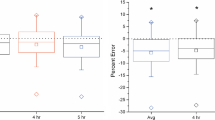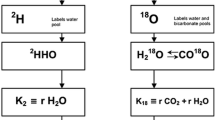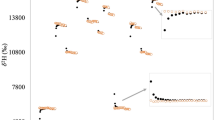Summary
The energy expenditure of free-living animals has been studied extensively by the doubly-labeled water (DLW) technique. This method provides a reasonably accurate estimate of daily energy needs. However, there is considerable interest in the energy demands of animals over much shorter timescales, for which the DLW technique is less useful. We examined the possibility of measuring the expenditure of small animals over these shorter timescales from the washout kinetics of a bolus dose of13C labeled bicarbonate. The study involved 19 laboratory mice which were injected either IP or SC with 0.2 ml of13C labeled bicarbonate in water. Mice were placed in a standard respirometry system, maintained at different temperatures to precipitate a 3 fold variation in metabolism. Samples of breath were collected from the chamber into vacutainers at one minute intervals for approximately 40 minutes to an hour. Samples were analyzed by admission to a mass spectrometer (VG Optima) via a GC interface which identified and admitted the CO2 peak. The log converted isotope elimination was linear (r2>98% in all cases) indicating a single pool was involved. We evaluated the pool size from a dilution series of the injectate in equilibrium with CO2 gas. Conventional compartmental analysis produced an estimate which on average across the 19 individuals provided a reasonable estimate of the CO2 production. Individual estimates were however imprecise and the overall correlation between isotope and calorimeter estimates had an r2 of only 15%. Reasons for this discrepancy are unclear. Nevertheless an empirical model, using the elimination gradient, pool size and route of isotope administration as predictors explained 86% of the variation in CO2 production. Elimination of a bolus dose of13C labeled bicarbonate provides a useful tool for estimating the energy metabolism of mice over intervals between 15 and 40 minutes.
Zusammenfassung
Der Energieumsatz von frei lebenden Tieren wurde in zahlreichen Untersuchungen mit der doppeltmarkierten Wassermethode (DLWM) bestimmt. Diese Methode liefert ausreichend genaue Ergebnisse für den täglichen Energiebedarf. Es besteht jedoch ein beachtliches Interesse für Messungen über kürzere Zeiträume, die mit Hilfe der DLWM nicht erfaßt werden können. Wir prüften die Möglichkeit zur Messung des Energieumsatzes von kleinen Tieren über kürzere Zeiträume anhand der Auswaschkinetik nach einem Bolus von13C-markiertem Bicarbonat.13C-markiertes Bicarbonat (gelöst in Wasser) wurde 19 Labormäusen i. p. oder s. c. injiziert (0,2 ml). Die Mäuse befanden sich in einem Standardrespiration-System. Die Messung fand bei 3 verschiedenen Temperaturen statt. Die Atemproben wurden minütlich über 40 – 60 min aus der Respirationkammer gewonnen und in Vacutainer abgefüllt. Die Proben wurden über ein GC-Interface in das Massenspektrometer (VG Optima) eingelassen und gemessen. Die halblogarithmische13C-Ausscheidung war linear (r2>98% in allen Fällen), was auf einen einzelnen Pool hinweist. Wir bestimmten die Poolgröße aus der13C-Verdünnungskurve. Die Kompartimentanalyse lieferte für die 19 Tiere einen vernünftigen Mittelwert der CO2-Produktion. Die individuellen Werte waren jedoch ungenau. Die Korrelation zwischen den Werten aus der Isotopenmethode und der indirekten Kalorimetrie war schlecht (r2=15%). Die Gründe für diese Diskrepanz sind unklar. Ein empirisches Modell, welches den Ausscheidungsgradienten, die Poolgröße und die Applikationsart der Tracers berücksichtigte, erklärte 86% der Variation der CO2-Produktion. Die13C-Methode ist ein brauchbares Hilfsmittel, um den Energieumsatz von Mäusen über einen Zeitraum von 15 – 40 min zu bestimmen.
Similar content being viewed by others
References
Elia M, Jones MG, Jennings G, Poppitt SD, Fuller NJ, Murgatroyd PR, Jebb SA (1995) Estimating energy expenditure from specific activity of urine urea during lengthy subcutaneous NaH14CO3 infusion. Am J Physiol 269:E172–182
Hayes JP, Speakman JR, Racey PA (1992) Sampling bias in respirometry. Physiol Zool 65:604–619
James WPT, Haggarty P, McGaw BA (1988) Recent progress in studies on energy expenditure: are the new methods providing answers to the old questions. Proc Nutr Soc 47:195–208
Lifson N, Gordon GB, Visscher MB, Neir AO (1949) The fate of utilised molecular oxygen and the source of the oxygen of respiratory carbon dioxide studied with the aid of heavy oxygen. J Biol Chem 180:803–811
Lifson N, Gordon GB, McClintock R (1955) Measurement of total carbon dioxide production by means of D2O18. J Appl Physiol 7:704–710
Nagy KA (1980) CO2 production in animals: analysis of potential errors in the doubly labeled water method. Am J Physiol 238:R466–473
Schoeller DA, Ravussin E, Schutz Y, Acheson KJ, Baetschi P, Jequier E (1986) Energy expenditure by doubly labeled water: validation in humans and proposed calculation. Am J Physiol 250:R823–830
Speakman JR (1997) Doubly labeled water: Theory and Practice. Chapman and Hall London
White RG, Leng RA (1969) Carbon dioxide entry rate as an index of energy expenditure in lambs. Proc Aust Soc Anim Prod 7:335–351
Young BA, Corbett JL (1969) Energy requirement for maintenance of grazing sheep measured by calorimetric techniques. Proc Aust Soc Anim Prod 7:327–334
Author information
Authors and Affiliations
Rights and permissions
About this article
Cite this article
Speakman, J.R., Thomson, S.C. Validation of the labeled bicarbonate technique for measurement of short-term energy expenditure in the mouse. Z Ernährungswiss 36, 273–277 (1997). https://doi.org/10.1007/BF01617797
Published:
Issue Date:
DOI: https://doi.org/10.1007/BF01617797




